Sainsbury's: Analyzing Structure, Culture, and Management Practices
VerifiedAdded on 2021/02/22
|9
|2546
|51
Report
AI Summary
This report provides a comprehensive analysis of Sainsbury's organizational structure and culture. It begins by defining organizational structure and culture and then examines Sainsbury's specific approach, including the impact of its culture on employee performance. The report delves into Handy's model of organizational culture, exploring role, power, person, and task cultures and their relevance to Sainsbury's. It then analyzes the nature of managerial work, outlining key management functions such as planning, organizing, staffing, directing, and controlling. The report further explores variables determining effective management and leadership, emphasizing motivation, training, and problem-solving. The path-goal theory and its application to Sainsbury's are examined, including directive, achievement-oriented, participative, and supportive leadership styles. Finally, the report considers the behavioral approach to management and its implications for Sainsbury's success. The conclusion highlights the importance of a well-defined structure and culture for organizational effectiveness and profitability.
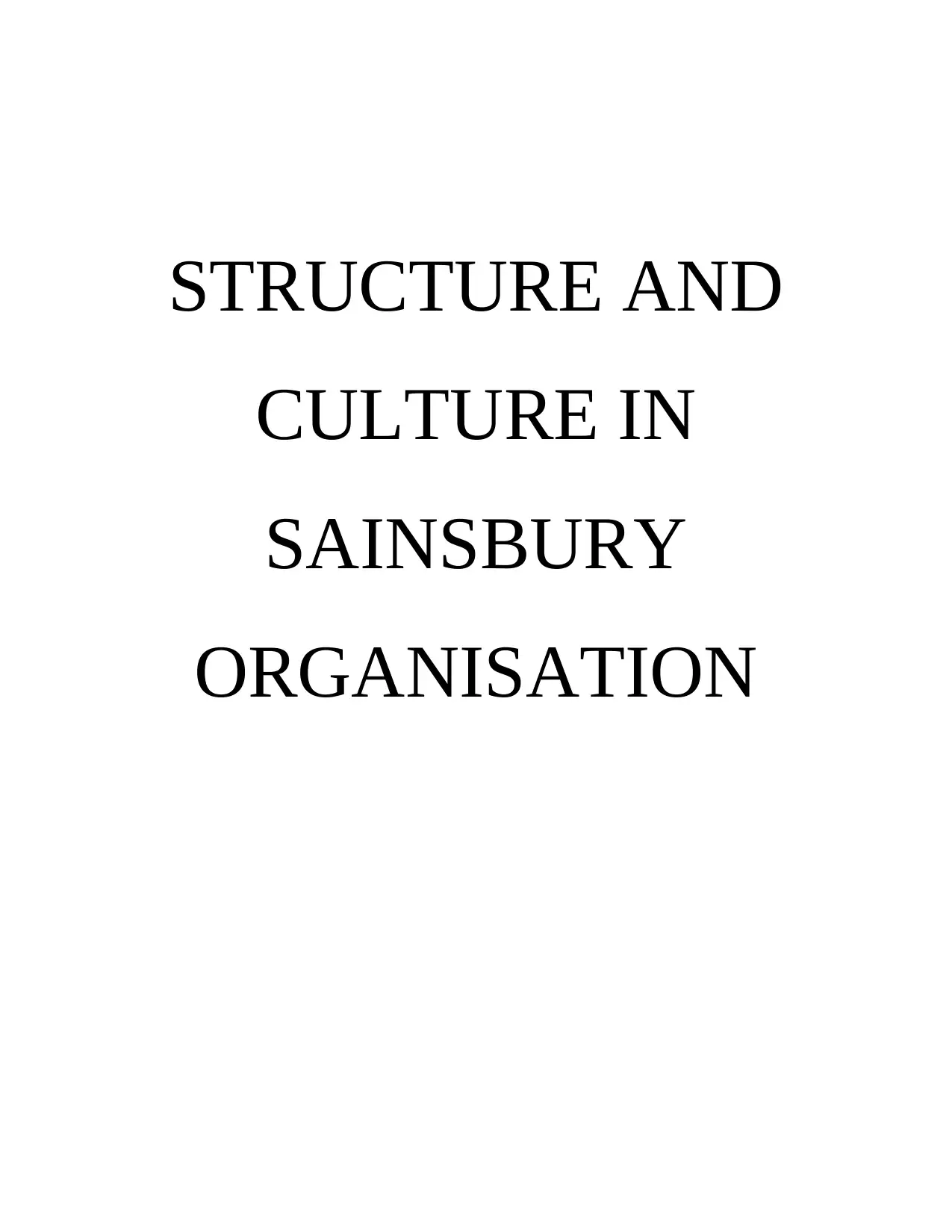
STRUCTURE AND
CULTURE IN
SAINSBURY
ORGANISATION
CULTURE IN
SAINSBURY
ORGANISATION
Paraphrase This Document
Need a fresh take? Get an instant paraphrase of this document with our AI Paraphraser
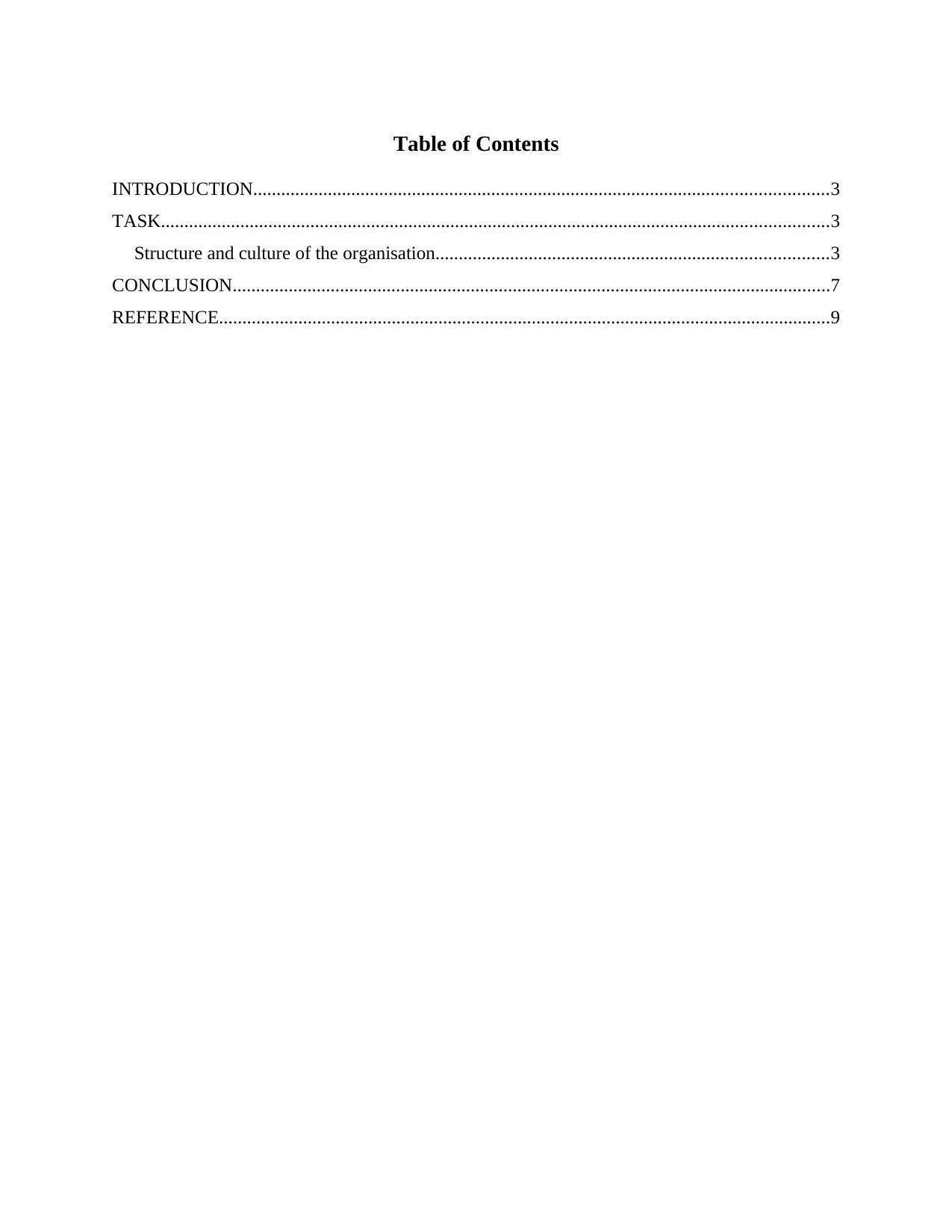
Table of Contents
INTRODUCTION...........................................................................................................................3
TASK...............................................................................................................................................3
Structure and culture of the organisation....................................................................................3
CONCLUSION................................................................................................................................7
REFERENCE...................................................................................................................................9
INTRODUCTION...........................................................................................................................3
TASK...............................................................................................................................................3
Structure and culture of the organisation....................................................................................3
CONCLUSION................................................................................................................................7
REFERENCE...................................................................................................................................9
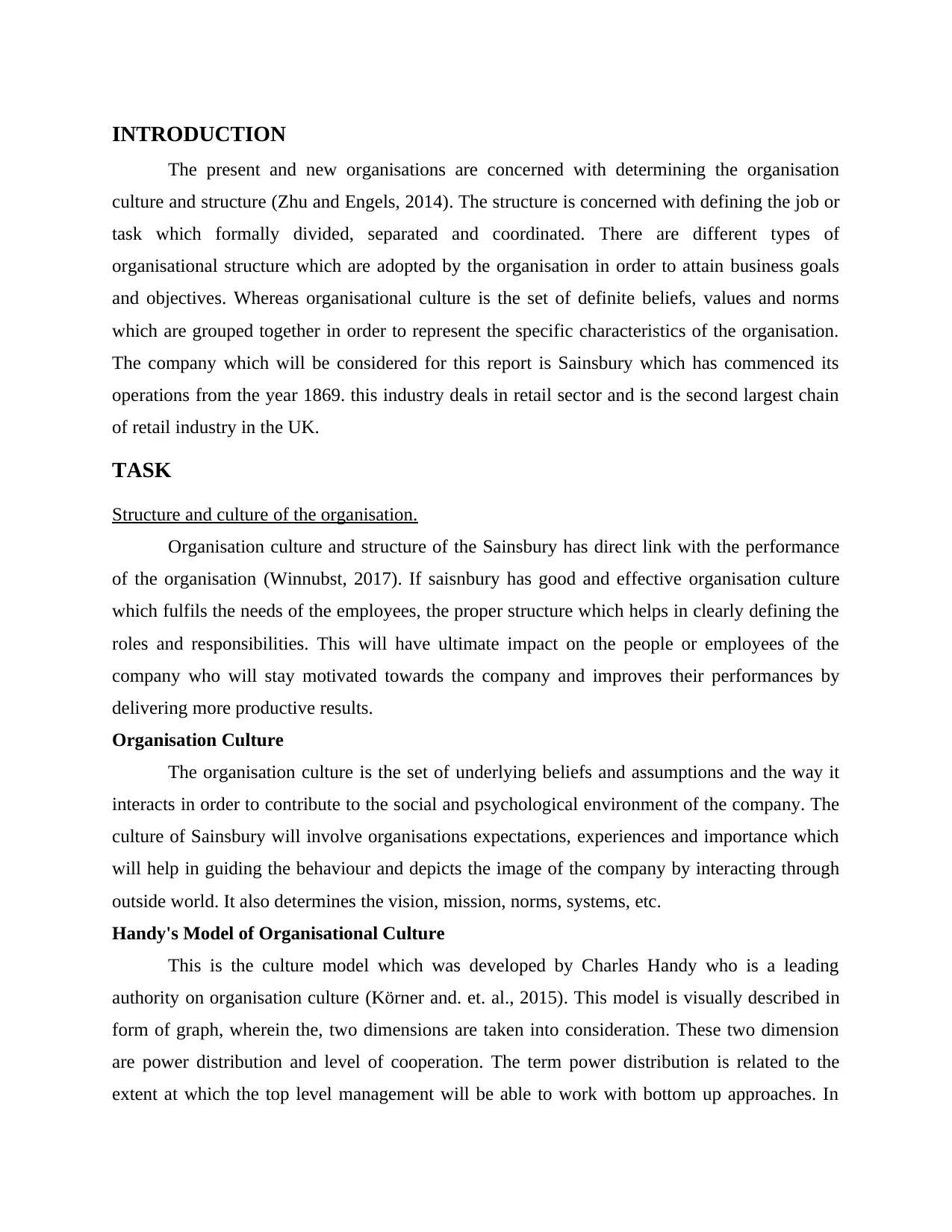
INTRODUCTION
The present and new organisations are concerned with determining the organisation
culture and structure (Zhu and Engels, 2014). The structure is concerned with defining the job or
task which formally divided, separated and coordinated. There are different types of
organisational structure which are adopted by the organisation in order to attain business goals
and objectives. Whereas organisational culture is the set of definite beliefs, values and norms
which are grouped together in order to represent the specific characteristics of the organisation.
The company which will be considered for this report is Sainsbury which has commenced its
operations from the year 1869. this industry deals in retail sector and is the second largest chain
of retail industry in the UK.
TASK
Structure and culture of the organisation.
Organisation culture and structure of the Sainsbury has direct link with the performance
of the organisation (Winnubst, 2017). If saisnbury has good and effective organisation culture
which fulfils the needs of the employees, the proper structure which helps in clearly defining the
roles and responsibilities. This will have ultimate impact on the people or employees of the
company who will stay motivated towards the company and improves their performances by
delivering more productive results.
Organisation Culture
The organisation culture is the set of underlying beliefs and assumptions and the way it
interacts in order to contribute to the social and psychological environment of the company. The
culture of Sainsbury will involve organisations expectations, experiences and importance which
will help in guiding the behaviour and depicts the image of the company by interacting through
outside world. It also determines the vision, mission, norms, systems, etc.
Handy's Model of Organisational Culture
This is the culture model which was developed by Charles Handy who is a leading
authority on organisation culture (Körner and. et. al., 2015). This model is visually described in
form of graph, wherein the, two dimensions are taken into consideration. These two dimension
are power distribution and level of cooperation. The term power distribution is related to the
extent at which the top level management will be able to work with bottom up approaches. In
The present and new organisations are concerned with determining the organisation
culture and structure (Zhu and Engels, 2014). The structure is concerned with defining the job or
task which formally divided, separated and coordinated. There are different types of
organisational structure which are adopted by the organisation in order to attain business goals
and objectives. Whereas organisational culture is the set of definite beliefs, values and norms
which are grouped together in order to represent the specific characteristics of the organisation.
The company which will be considered for this report is Sainsbury which has commenced its
operations from the year 1869. this industry deals in retail sector and is the second largest chain
of retail industry in the UK.
TASK
Structure and culture of the organisation.
Organisation culture and structure of the Sainsbury has direct link with the performance
of the organisation (Winnubst, 2017). If saisnbury has good and effective organisation culture
which fulfils the needs of the employees, the proper structure which helps in clearly defining the
roles and responsibilities. This will have ultimate impact on the people or employees of the
company who will stay motivated towards the company and improves their performances by
delivering more productive results.
Organisation Culture
The organisation culture is the set of underlying beliefs and assumptions and the way it
interacts in order to contribute to the social and psychological environment of the company. The
culture of Sainsbury will involve organisations expectations, experiences and importance which
will help in guiding the behaviour and depicts the image of the company by interacting through
outside world. It also determines the vision, mission, norms, systems, etc.
Handy's Model of Organisational Culture
This is the culture model which was developed by Charles Handy who is a leading
authority on organisation culture (Körner and. et. al., 2015). This model is visually described in
form of graph, wherein the, two dimensions are taken into consideration. These two dimension
are power distribution and level of cooperation. The term power distribution is related to the
extent at which the top level management will be able to work with bottom up approaches. In
⊘ This is a preview!⊘
Do you want full access?
Subscribe today to unlock all pages.

Trusted by 1+ million students worldwide
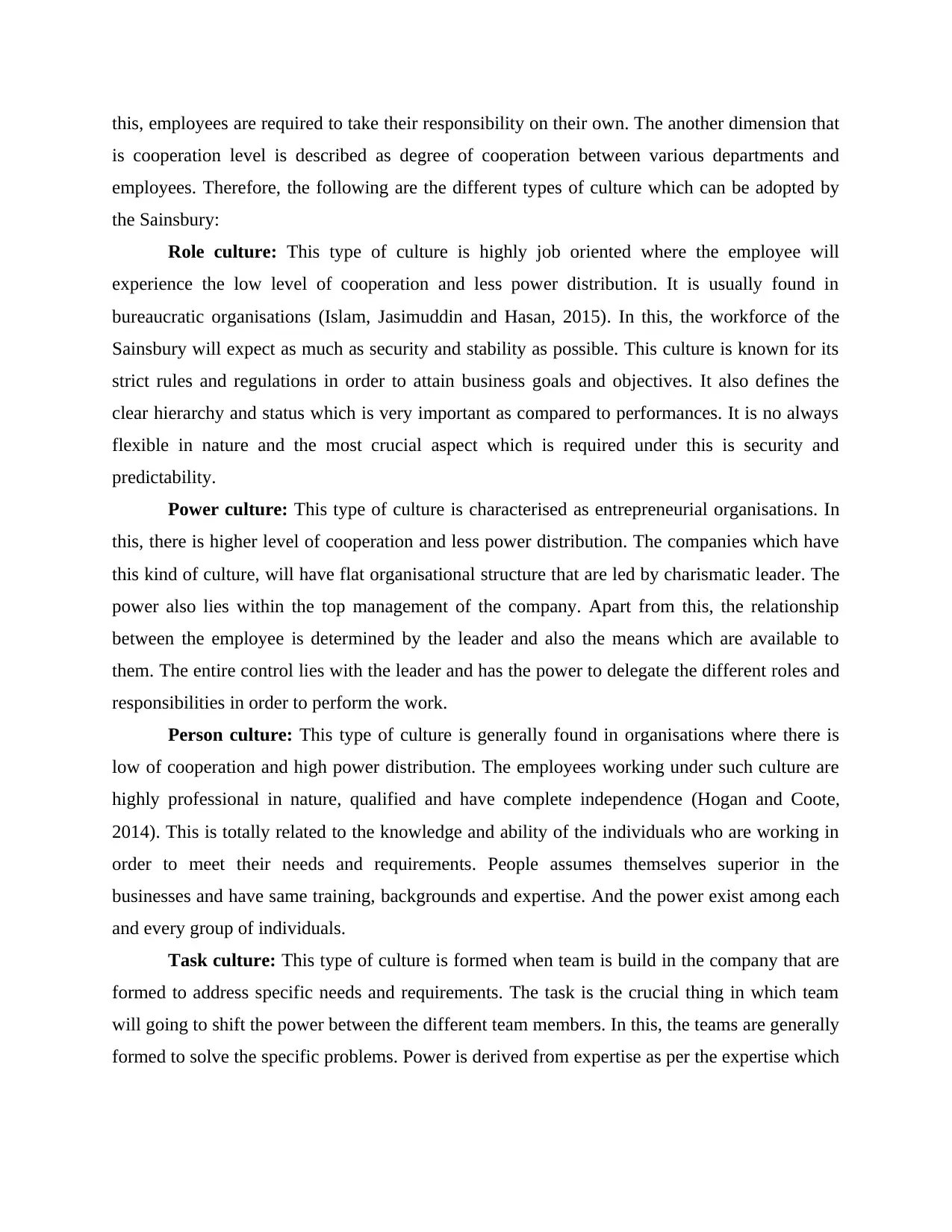
this, employees are required to take their responsibility on their own. The another dimension that
is cooperation level is described as degree of cooperation between various departments and
employees. Therefore, the following are the different types of culture which can be adopted by
the Sainsbury:
Role culture: This type of culture is highly job oriented where the employee will
experience the low level of cooperation and less power distribution. It is usually found in
bureaucratic organisations (Islam, Jasimuddin and Hasan, 2015). In this, the workforce of the
Sainsbury will expect as much as security and stability as possible. This culture is known for its
strict rules and regulations in order to attain business goals and objectives. It also defines the
clear hierarchy and status which is very important as compared to performances. It is no always
flexible in nature and the most crucial aspect which is required under this is security and
predictability.
Power culture: This type of culture is characterised as entrepreneurial organisations. In
this, there is higher level of cooperation and less power distribution. The companies which have
this kind of culture, will have flat organisational structure that are led by charismatic leader. The
power also lies within the top management of the company. Apart from this, the relationship
between the employee is determined by the leader and also the means which are available to
them. The entire control lies with the leader and has the power to delegate the different roles and
responsibilities in order to perform the work.
Person culture: This type of culture is generally found in organisations where there is
low of cooperation and high power distribution. The employees working under such culture are
highly professional in nature, qualified and have complete independence (Hogan and Coote,
2014). This is totally related to the knowledge and ability of the individuals who are working in
order to meet their needs and requirements. People assumes themselves superior in the
businesses and have same training, backgrounds and expertise. And the power exist among each
and every group of individuals.
Task culture: This type of culture is formed when team is build in the company that are
formed to address specific needs and requirements. The task is the crucial thing in which team
will going to shift the power between the different team members. In this, the teams are generally
formed to solve the specific problems. Power is derived from expertise as per the expertise which
is cooperation level is described as degree of cooperation between various departments and
employees. Therefore, the following are the different types of culture which can be adopted by
the Sainsbury:
Role culture: This type of culture is highly job oriented where the employee will
experience the low level of cooperation and less power distribution. It is usually found in
bureaucratic organisations (Islam, Jasimuddin and Hasan, 2015). In this, the workforce of the
Sainsbury will expect as much as security and stability as possible. This culture is known for its
strict rules and regulations in order to attain business goals and objectives. It also defines the
clear hierarchy and status which is very important as compared to performances. It is no always
flexible in nature and the most crucial aspect which is required under this is security and
predictability.
Power culture: This type of culture is characterised as entrepreneurial organisations. In
this, there is higher level of cooperation and less power distribution. The companies which have
this kind of culture, will have flat organisational structure that are led by charismatic leader. The
power also lies within the top management of the company. Apart from this, the relationship
between the employee is determined by the leader and also the means which are available to
them. The entire control lies with the leader and has the power to delegate the different roles and
responsibilities in order to perform the work.
Person culture: This type of culture is generally found in organisations where there is
low of cooperation and high power distribution. The employees working under such culture are
highly professional in nature, qualified and have complete independence (Hogan and Coote,
2014). This is totally related to the knowledge and ability of the individuals who are working in
order to meet their needs and requirements. People assumes themselves superior in the
businesses and have same training, backgrounds and expertise. And the power exist among each
and every group of individuals.
Task culture: This type of culture is formed when team is build in the company that are
formed to address specific needs and requirements. The task is the crucial thing in which team
will going to shift the power between the different team members. In this, the teams are generally
formed to solve the specific problems. Power is derived from expertise as per the expertise which
Paraphrase This Document
Need a fresh take? Get an instant paraphrase of this document with our AI Paraphraser
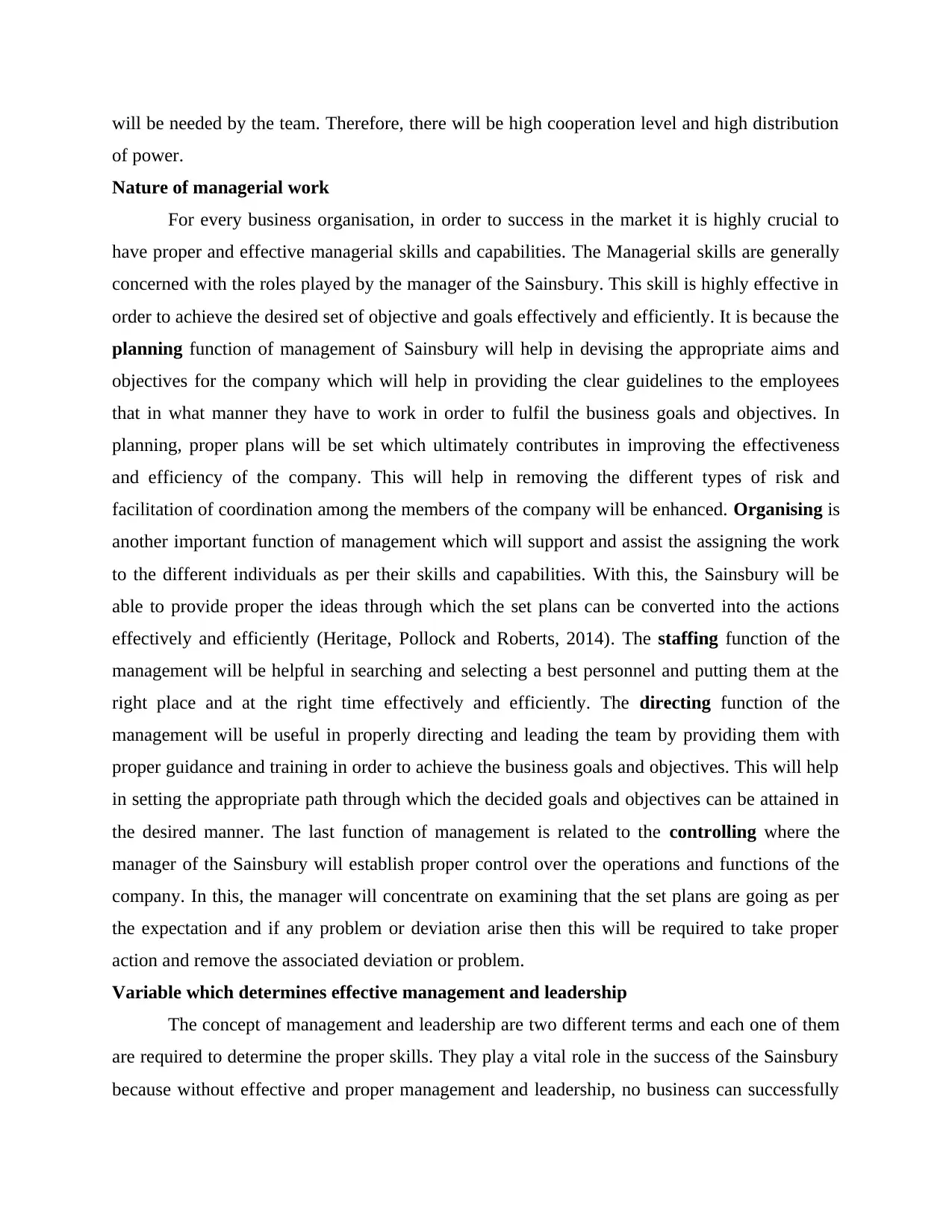
will be needed by the team. Therefore, there will be high cooperation level and high distribution
of power.
Nature of managerial work
For every business organisation, in order to success in the market it is highly crucial to
have proper and effective managerial skills and capabilities. The Managerial skills are generally
concerned with the roles played by the manager of the Sainsbury. This skill is highly effective in
order to achieve the desired set of objective and goals effectively and efficiently. It is because the
planning function of management of Sainsbury will help in devising the appropriate aims and
objectives for the company which will help in providing the clear guidelines to the employees
that in what manner they have to work in order to fulfil the business goals and objectives. In
planning, proper plans will be set which ultimately contributes in improving the effectiveness
and efficiency of the company. This will help in removing the different types of risk and
facilitation of coordination among the members of the company will be enhanced. Organising is
another important function of management which will support and assist the assigning the work
to the different individuals as per their skills and capabilities. With this, the Sainsbury will be
able to provide proper the ideas through which the set plans can be converted into the actions
effectively and efficiently (Heritage, Pollock and Roberts, 2014). The staffing function of the
management will be helpful in searching and selecting a best personnel and putting them at the
right place and at the right time effectively and efficiently. The directing function of the
management will be useful in properly directing and leading the team by providing them with
proper guidance and training in order to achieve the business goals and objectives. This will help
in setting the appropriate path through which the decided goals and objectives can be attained in
the desired manner. The last function of management is related to the controlling where the
manager of the Sainsbury will establish proper control over the operations and functions of the
company. In this, the manager will concentrate on examining that the set plans are going as per
the expectation and if any problem or deviation arise then this will be required to take proper
action and remove the associated deviation or problem.
Variable which determines effective management and leadership
The concept of management and leadership are two different terms and each one of them
are required to determine the proper skills. They play a vital role in the success of the Sainsbury
because without effective and proper management and leadership, no business can successfully
of power.
Nature of managerial work
For every business organisation, in order to success in the market it is highly crucial to
have proper and effective managerial skills and capabilities. The Managerial skills are generally
concerned with the roles played by the manager of the Sainsbury. This skill is highly effective in
order to achieve the desired set of objective and goals effectively and efficiently. It is because the
planning function of management of Sainsbury will help in devising the appropriate aims and
objectives for the company which will help in providing the clear guidelines to the employees
that in what manner they have to work in order to fulfil the business goals and objectives. In
planning, proper plans will be set which ultimately contributes in improving the effectiveness
and efficiency of the company. This will help in removing the different types of risk and
facilitation of coordination among the members of the company will be enhanced. Organising is
another important function of management which will support and assist the assigning the work
to the different individuals as per their skills and capabilities. With this, the Sainsbury will be
able to provide proper the ideas through which the set plans can be converted into the actions
effectively and efficiently (Heritage, Pollock and Roberts, 2014). The staffing function of the
management will be helpful in searching and selecting a best personnel and putting them at the
right place and at the right time effectively and efficiently. The directing function of the
management will be useful in properly directing and leading the team by providing them with
proper guidance and training in order to achieve the business goals and objectives. This will help
in setting the appropriate path through which the decided goals and objectives can be attained in
the desired manner. The last function of management is related to the controlling where the
manager of the Sainsbury will establish proper control over the operations and functions of the
company. In this, the manager will concentrate on examining that the set plans are going as per
the expectation and if any problem or deviation arise then this will be required to take proper
action and remove the associated deviation or problem.
Variable which determines effective management and leadership
The concept of management and leadership are two different terms and each one of them
are required to determine the proper skills. They play a vital role in the success of the Sainsbury
because without effective and proper management and leadership, no business can successfully
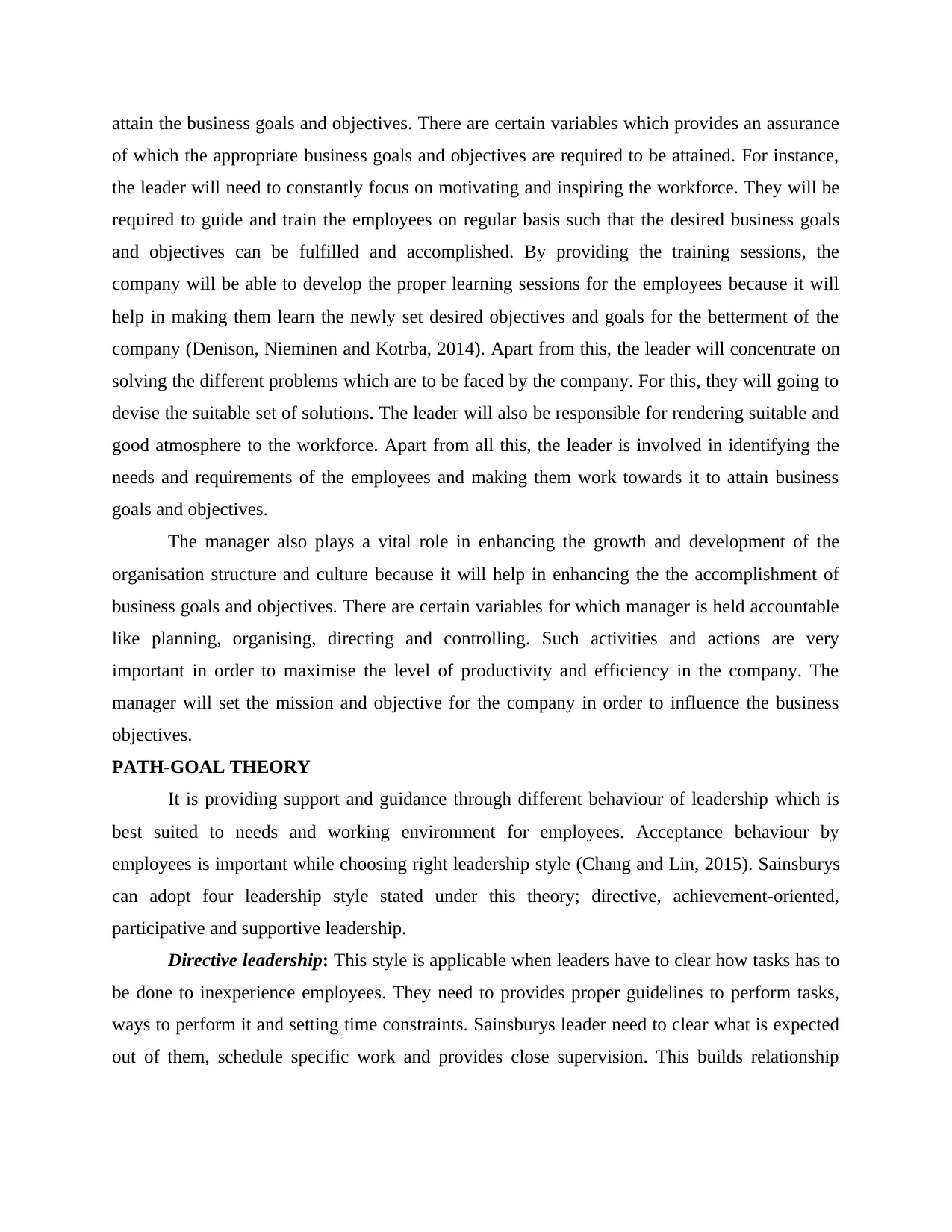
attain the business goals and objectives. There are certain variables which provides an assurance
of which the appropriate business goals and objectives are required to be attained. For instance,
the leader will need to constantly focus on motivating and inspiring the workforce. They will be
required to guide and train the employees on regular basis such that the desired business goals
and objectives can be fulfilled and accomplished. By providing the training sessions, the
company will be able to develop the proper learning sessions for the employees because it will
help in making them learn the newly set desired objectives and goals for the betterment of the
company (Denison, Nieminen and Kotrba, 2014). Apart from this, the leader will concentrate on
solving the different problems which are to be faced by the company. For this, they will going to
devise the suitable set of solutions. The leader will also be responsible for rendering suitable and
good atmosphere to the workforce. Apart from all this, the leader is involved in identifying the
needs and requirements of the employees and making them work towards it to attain business
goals and objectives.
The manager also plays a vital role in enhancing the growth and development of the
organisation structure and culture because it will help in enhancing the the accomplishment of
business goals and objectives. There are certain variables for which manager is held accountable
like planning, organising, directing and controlling. Such activities and actions are very
important in order to maximise the level of productivity and efficiency in the company. The
manager will set the mission and objective for the company in order to influence the business
objectives.
PATH-GOAL THEORY
It is providing support and guidance through different behaviour of leadership which is
best suited to needs and working environment for employees. Acceptance behaviour by
employees is important while choosing right leadership style (Chang and Lin, 2015). Sainsburys
can adopt four leadership style stated under this theory; directive, achievement-oriented,
participative and supportive leadership.
Directive leadership: This style is applicable when leaders have to clear how tasks has to
be done to inexperience employees. They need to provides proper guidelines to perform tasks,
ways to perform it and setting time constraints. Sainsburys leader need to clear what is expected
out of them, schedule specific work and provides close supervision. This builds relationship
of which the appropriate business goals and objectives are required to be attained. For instance,
the leader will need to constantly focus on motivating and inspiring the workforce. They will be
required to guide and train the employees on regular basis such that the desired business goals
and objectives can be fulfilled and accomplished. By providing the training sessions, the
company will be able to develop the proper learning sessions for the employees because it will
help in making them learn the newly set desired objectives and goals for the betterment of the
company (Denison, Nieminen and Kotrba, 2014). Apart from this, the leader will concentrate on
solving the different problems which are to be faced by the company. For this, they will going to
devise the suitable set of solutions. The leader will also be responsible for rendering suitable and
good atmosphere to the workforce. Apart from all this, the leader is involved in identifying the
needs and requirements of the employees and making them work towards it to attain business
goals and objectives.
The manager also plays a vital role in enhancing the growth and development of the
organisation structure and culture because it will help in enhancing the the accomplishment of
business goals and objectives. There are certain variables for which manager is held accountable
like planning, organising, directing and controlling. Such activities and actions are very
important in order to maximise the level of productivity and efficiency in the company. The
manager will set the mission and objective for the company in order to influence the business
objectives.
PATH-GOAL THEORY
It is providing support and guidance through different behaviour of leadership which is
best suited to needs and working environment for employees. Acceptance behaviour by
employees is important while choosing right leadership style (Chang and Lin, 2015). Sainsburys
can adopt four leadership style stated under this theory; directive, achievement-oriented,
participative and supportive leadership.
Directive leadership: This style is applicable when leaders have to clear how tasks has to
be done to inexperience employees. They need to provides proper guidelines to perform tasks,
ways to perform it and setting time constraints. Sainsburys leader need to clear what is expected
out of them, schedule specific work and provides close supervision. This builds relationship
⊘ This is a preview!⊘
Do you want full access?
Subscribe today to unlock all pages.

Trusted by 1+ million students worldwide
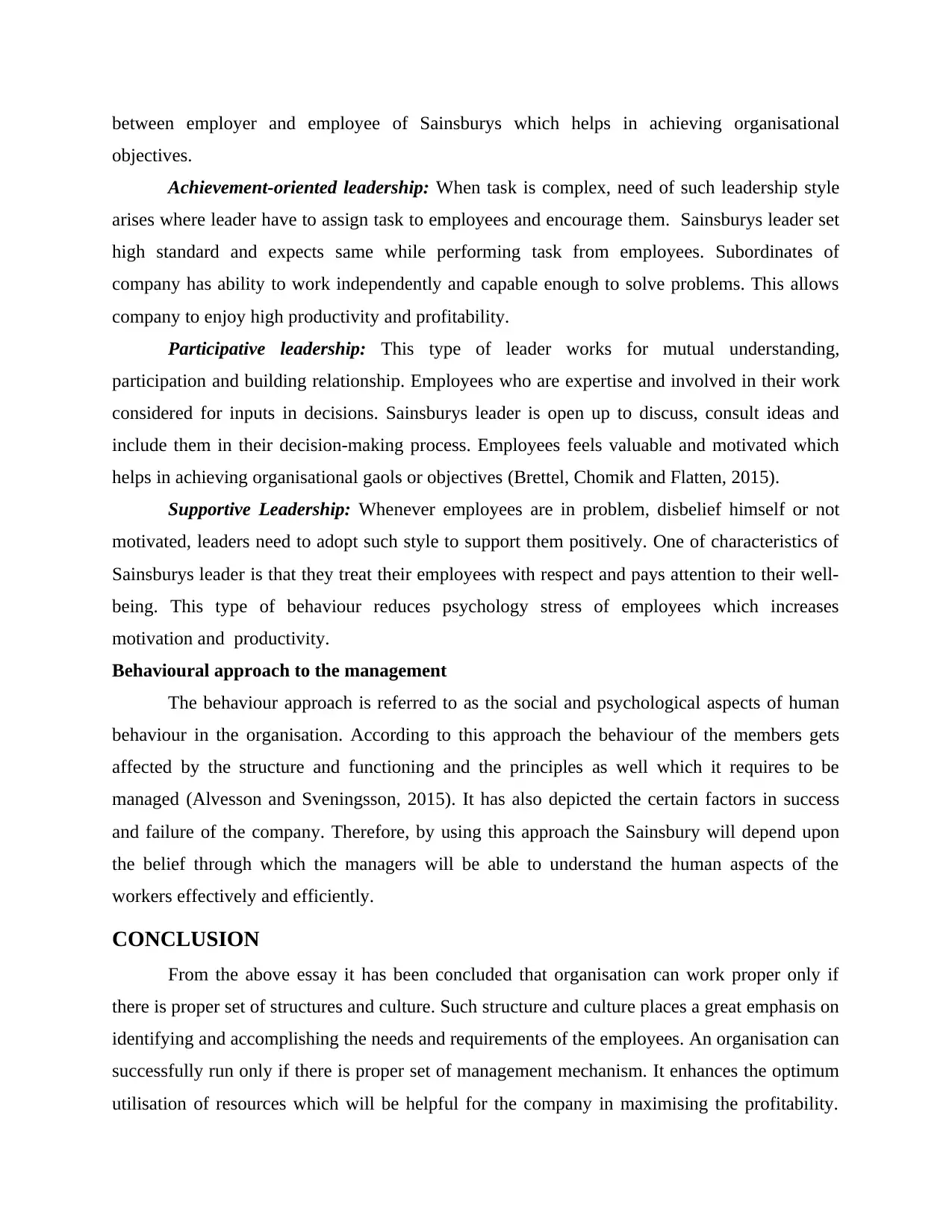
between employer and employee of Sainsburys which helps in achieving organisational
objectives.
Achievement-oriented leadership: When task is complex, need of such leadership style
arises where leader have to assign task to employees and encourage them. Sainsburys leader set
high standard and expects same while performing task from employees. Subordinates of
company has ability to work independently and capable enough to solve problems. This allows
company to enjoy high productivity and profitability.
Participative leadership: This type of leader works for mutual understanding,
participation and building relationship. Employees who are expertise and involved in their work
considered for inputs in decisions. Sainsburys leader is open up to discuss, consult ideas and
include them in their decision-making process. Employees feels valuable and motivated which
helps in achieving organisational gaols or objectives (Brettel, Chomik and Flatten, 2015).
Supportive Leadership: Whenever employees are in problem, disbelief himself or not
motivated, leaders need to adopt such style to support them positively. One of characteristics of
Sainsburys leader is that they treat their employees with respect and pays attention to their well-
being. This type of behaviour reduces psychology stress of employees which increases
motivation and productivity.
Behavioural approach to the management
The behaviour approach is referred to as the social and psychological aspects of human
behaviour in the organisation. According to this approach the behaviour of the members gets
affected by the structure and functioning and the principles as well which it requires to be
managed (Alvesson and Sveningsson, 2015). It has also depicted the certain factors in success
and failure of the company. Therefore, by using this approach the Sainsbury will depend upon
the belief through which the managers will be able to understand the human aspects of the
workers effectively and efficiently.
CONCLUSION
From the above essay it has been concluded that organisation can work proper only if
there is proper set of structures and culture. Such structure and culture places a great emphasis on
identifying and accomplishing the needs and requirements of the employees. An organisation can
successfully run only if there is proper set of management mechanism. It enhances the optimum
utilisation of resources which will be helpful for the company in maximising the profitability.
objectives.
Achievement-oriented leadership: When task is complex, need of such leadership style
arises where leader have to assign task to employees and encourage them. Sainsburys leader set
high standard and expects same while performing task from employees. Subordinates of
company has ability to work independently and capable enough to solve problems. This allows
company to enjoy high productivity and profitability.
Participative leadership: This type of leader works for mutual understanding,
participation and building relationship. Employees who are expertise and involved in their work
considered for inputs in decisions. Sainsburys leader is open up to discuss, consult ideas and
include them in their decision-making process. Employees feels valuable and motivated which
helps in achieving organisational gaols or objectives (Brettel, Chomik and Flatten, 2015).
Supportive Leadership: Whenever employees are in problem, disbelief himself or not
motivated, leaders need to adopt such style to support them positively. One of characteristics of
Sainsburys leader is that they treat their employees with respect and pays attention to their well-
being. This type of behaviour reduces psychology stress of employees which increases
motivation and productivity.
Behavioural approach to the management
The behaviour approach is referred to as the social and psychological aspects of human
behaviour in the organisation. According to this approach the behaviour of the members gets
affected by the structure and functioning and the principles as well which it requires to be
managed (Alvesson and Sveningsson, 2015). It has also depicted the certain factors in success
and failure of the company. Therefore, by using this approach the Sainsbury will depend upon
the belief through which the managers will be able to understand the human aspects of the
workers effectively and efficiently.
CONCLUSION
From the above essay it has been concluded that organisation can work proper only if
there is proper set of structures and culture. Such structure and culture places a great emphasis on
identifying and accomplishing the needs and requirements of the employees. An organisation can
successfully run only if there is proper set of management mechanism. It enhances the optimum
utilisation of resources which will be helpful for the company in maximising the profitability.
Paraphrase This Document
Need a fresh take? Get an instant paraphrase of this document with our AI Paraphraser

This not only involves the performance of different actions but it also enhances the grooming
and development of skills and personality of the workers.
and development of skills and personality of the workers.
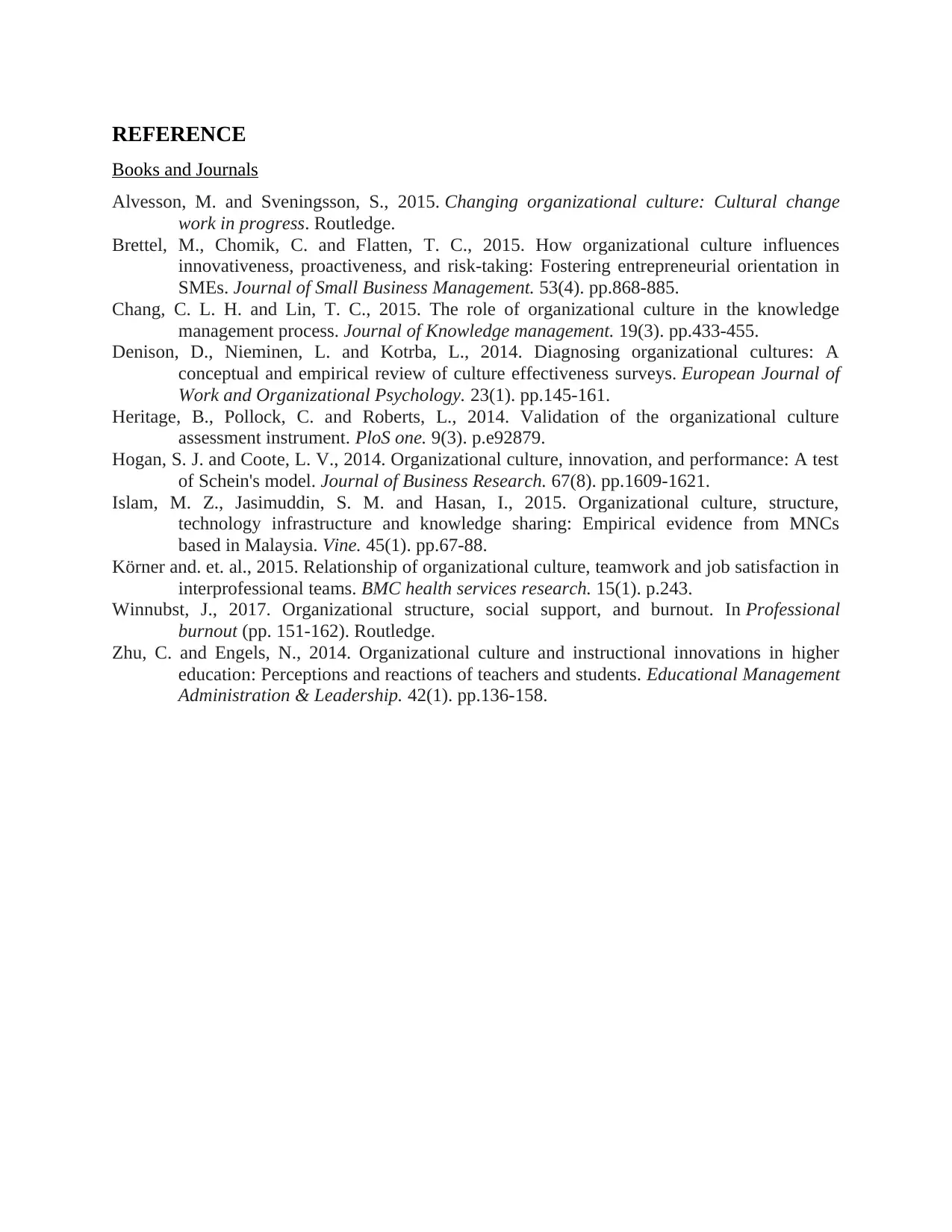
REFERENCE
Books and Journals
Alvesson, M. and Sveningsson, S., 2015. Changing organizational culture: Cultural change
work in progress. Routledge.
Brettel, M., Chomik, C. and Flatten, T. C., 2015. How organizational culture influences
innovativeness, proactiveness, and risk‐taking: Fostering entrepreneurial orientation in
SMEs. Journal of Small Business Management. 53(4). pp.868-885.
Chang, C. L. H. and Lin, T. C., 2015. The role of organizational culture in the knowledge
management process. Journal of Knowledge management. 19(3). pp.433-455.
Denison, D., Nieminen, L. and Kotrba, L., 2014. Diagnosing organizational cultures: A
conceptual and empirical review of culture effectiveness surveys. European Journal of
Work and Organizational Psychology. 23(1). pp.145-161.
Heritage, B., Pollock, C. and Roberts, L., 2014. Validation of the organizational culture
assessment instrument. PloS one. 9(3). p.e92879.
Hogan, S. J. and Coote, L. V., 2014. Organizational culture, innovation, and performance: A test
of Schein's model. Journal of Business Research. 67(8). pp.1609-1621.
Islam, M. Z., Jasimuddin, S. M. and Hasan, I., 2015. Organizational culture, structure,
technology infrastructure and knowledge sharing: Empirical evidence from MNCs
based in Malaysia. Vine. 45(1). pp.67-88.
Körner and. et. al., 2015. Relationship of organizational culture, teamwork and job satisfaction in
interprofessional teams. BMC health services research. 15(1). p.243.
Winnubst, J., 2017. Organizational structure, social support, and burnout. In Professional
burnout (pp. 151-162). Routledge.
Zhu, C. and Engels, N., 2014. Organizational culture and instructional innovations in higher
education: Perceptions and reactions of teachers and students. Educational Management
Administration & Leadership. 42(1). pp.136-158.
Books and Journals
Alvesson, M. and Sveningsson, S., 2015. Changing organizational culture: Cultural change
work in progress. Routledge.
Brettel, M., Chomik, C. and Flatten, T. C., 2015. How organizational culture influences
innovativeness, proactiveness, and risk‐taking: Fostering entrepreneurial orientation in
SMEs. Journal of Small Business Management. 53(4). pp.868-885.
Chang, C. L. H. and Lin, T. C., 2015. The role of organizational culture in the knowledge
management process. Journal of Knowledge management. 19(3). pp.433-455.
Denison, D., Nieminen, L. and Kotrba, L., 2014. Diagnosing organizational cultures: A
conceptual and empirical review of culture effectiveness surveys. European Journal of
Work and Organizational Psychology. 23(1). pp.145-161.
Heritage, B., Pollock, C. and Roberts, L., 2014. Validation of the organizational culture
assessment instrument. PloS one. 9(3). p.e92879.
Hogan, S. J. and Coote, L. V., 2014. Organizational culture, innovation, and performance: A test
of Schein's model. Journal of Business Research. 67(8). pp.1609-1621.
Islam, M. Z., Jasimuddin, S. M. and Hasan, I., 2015. Organizational culture, structure,
technology infrastructure and knowledge sharing: Empirical evidence from MNCs
based in Malaysia. Vine. 45(1). pp.67-88.
Körner and. et. al., 2015. Relationship of organizational culture, teamwork and job satisfaction in
interprofessional teams. BMC health services research. 15(1). p.243.
Winnubst, J., 2017. Organizational structure, social support, and burnout. In Professional
burnout (pp. 151-162). Routledge.
Zhu, C. and Engels, N., 2014. Organizational culture and instructional innovations in higher
education: Perceptions and reactions of teachers and students. Educational Management
Administration & Leadership. 42(1). pp.136-158.
⊘ This is a preview!⊘
Do you want full access?
Subscribe today to unlock all pages.

Trusted by 1+ million students worldwide
1 out of 9
Related Documents
Your All-in-One AI-Powered Toolkit for Academic Success.
+13062052269
info@desklib.com
Available 24*7 on WhatsApp / Email
![[object Object]](/_next/static/media/star-bottom.7253800d.svg)
Unlock your academic potential
Copyright © 2020–2025 A2Z Services. All Rights Reserved. Developed and managed by ZUCOL.




